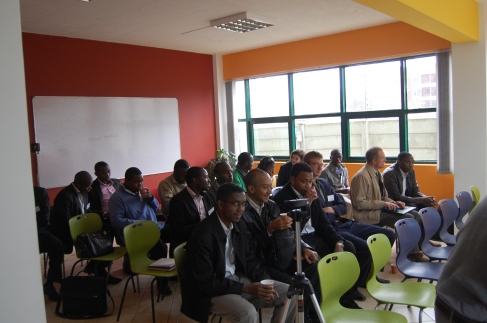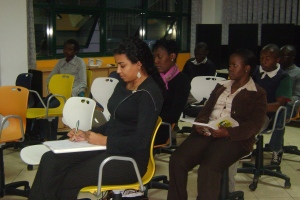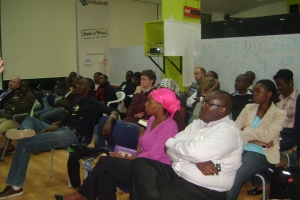A matatu pulls up to the stop. A man dangling from the open door peers into the faces of the waiting travelers, looking for customers.
“Yaya?” I enquire, the minibus still moving.
“Yaya.” The dangling man steps off the bus as two or three passengers disembark. I climb in, squeezing my way among the 15 people packed into the bus originally meant for probably 6-8. Before I have the chance to sit, the dangling man raps on the roof of the bus, still hanging out the door and the driver abruptly reels us into traffic. Eventually I manage to sit down, after having bashed three or four people with my backpack.
From my new position in the back of the bus, I survey the scene. I’m glad I got in first, because the person right after me sat on the seat in the doorway. As soon as we lurch into traffic, the dangling man slams the door shut and basically pushes the last passenger off her seat in the door, leaving half of her to hover in the narrow aisle.
The bus itself might be crumbling, but the sound system looks brand new – Pioneer surround sound – and music blasts, rattling some of the loose bits of the vehicle. I have to keep my head down to prevent it slamming into the ceiling when we hit bumps. And whenever the traffic is moving too slowly for the taste of the driver, he will suddenly pull into the lane with oncoming traffic, trying to skip ahead of as many cars as he can. Often this leads to oncoming traffic simply stopping, as they are completely blocked. Other times, the road manages to fit three lanes, flexing itself for the needs of our driver.

This picture is terrible but illustrative. In Kenya, you drive on the left, so the matatu on the right is driving completely across the road from where it should be. Two of the matatus wheels are not even on the road. When I encountered this one, it was chugging along the wrong shoulder like it was nothing. You can also barely make out that there is another matatu on the same shoulder going the opposite direction just beyond our foreground friend.
By the time we reach my destination – the Yaya Centre, a shopping center across the street from where I work – I am getting used to the setting. But getting in and out is the worst part of the journey. I undoubtedly break all sorts of cultural rules on both occasions, and I am glad if I can complete the journey without ripping my clothes. But I do manage to get out, and I wonder how the next journey will be.
***
Having now been in Nairobi for a few weeks, I am getting more used to matatu travel. But it is certainly always an adventure. Just the other day I failed to meet my primary objective – a journey without ripping clothes. It had been a fairly good journey at first – I’m fairly certain I only roughed up one person when entering the bus. But as I exited, I felt my shirt suddenly catch on something. The subsequent ripping sound confirmed my fear. It was one of my favorite shirts (alas!), but the tear was fortuitously small and discretely placed, so I think it can be salvaged.
Aside from the experience getting in and out of a matatu, this mode of transportation offers two other exciting components. While a few matatus are clean and unadorned, the vast majority bear some sort of banner written across the windshield or back window (see first picture above for example – “Glory to God”). Many are of a religious nature – “Jehovah,” “Jesus is my hero,” “Annoited [sic]”, and my personal favorite, “Biblical Avisory [sic] – Jesus saves.” Suffice it to say that public religious expression seems to be common here, much more so than in the US.
But many other banners are decidedly not religious, “Limousine Exotica” and “Bend Over” being two I have seen. Others do not seem to have a particular message, other than perhaps the preference of the driver – “Infinity,” “Las Vegas,” and “Weezy F,” for example.
The final excitement comes from payment. Native Kenyans have no problem with this, but as a mzungu (white person, or literally “aimless wanderer”), I stick out as an obvious target for exploitation, understandably. Within the first day, thanks to my friend here, I learned what I ought to pay for a ride to work – 30 Kenyan shillings, about $0.35. There are a few exceptions: the larger (and nicer) buses charge about double, weekends are normally cheaper, and so on.
Normally there is no problem. The operator taps you on the shoulder after you’ve been in the bus for a minute, and you hand him 30 KSH. But the other day I did not have exact change, so I gave a 50 KSH note instead. Usually the man will hand back the change promptly. But this time, he didn’t. So after both of the people sitting next to me had paid their 30 KSH, I started bugging the man to give me my change. But he was having none of it:
“It’s 50 shillings.”
“No it’s not – I know it’s 30, and both of these guys just paid 30.”
He laughs a winning laugh and flashes a smile. “Ha ha ha – no my friend, the charge is 50.”
“Dude, I saw them pay 30!”
“My friend, these are our people.”
Frankly, I was shocked that he had admitted he was overcharging me because I was a foreigner. Usually if you know the price, no one will give you any trouble, though of course they will try at first to overcharge (as they do for locals as well). I hassled the man some more but he simply wouldn’t budge. Eventually I got off and warned him I’d never take his matatu again, not that I even remember what he looked like now (as I’m sure he knew would happen).
Bargaining is part of life here, and I clearly lost that round, though that is the only time I know I was overcharged. I guess the story is worth the quarter it cost me anyway.
Needless to say, matatus are an adventure every time. I’m sure I’ll have more matatu stories for later posts.
Filed under:
Life and Culture,
Travel Tagged:
driving,
Kenya,
matatu,
Nairobi,
transportation 
















